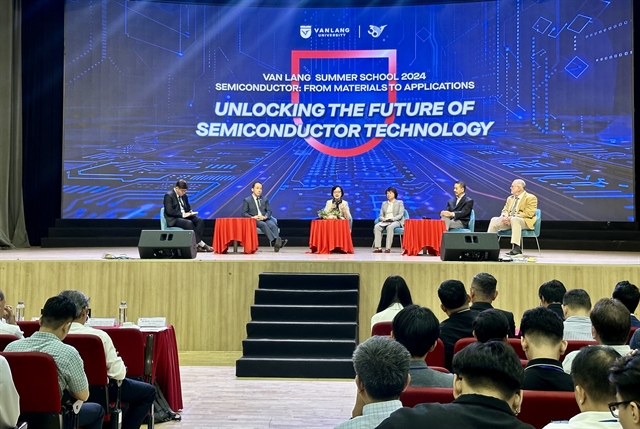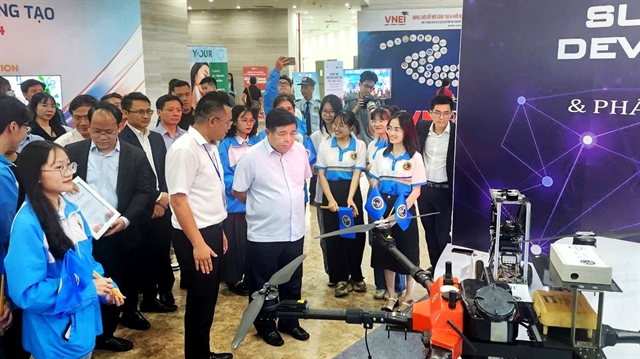 Society
Society

 |
| ENGAGED LEARNING: Engineering students conduct experiments at Saigon Hi-tech Park Training Centre in HCM City. — VNA/VNS Photo Thanh Vũ |
by Bảo Hoa
Young people in Việt Nam are at the forefront of innovation and technological changes, particularly in AI and semiconductor production.
These industries are viewed as essential for driving economic breakthroughs, helping the country transition out of the middle-income trap. As a result, the younger generation is placed at the centre of this transformation, both in terms of opportunities and challenges.
Trần Đăng Hòa, chair of FPT Information System (FPT IS), believes that young Vietnamese professionals have a unique opportunity to excel in these industries, which are forecast to reach a US$1 trillion market value by 2030.
"Việt Nam has strong advantages in these sectors and is building a solid reputation," Hòa said, underscoring that the country's investment in STEM (science, technology, engineering, and mathematics) subjects is paying off.
According to Hòa, the country has long been recognised for its excellence in mathematics, physics and chemistry, fields that are crucial for AI and semiconductor production.
"The government’s emphasis on STEM education is vital for the future, ensuring that young people will have the skills to thrive in these sectors," he said.
Amid the rapid technological advancements, young Vietnamese like Lương Thị Nhung, a third-year student at the University of Transport and Communications, are both excited and apprehensive.
Majoring in logistics and supply chain management, Nhung uses software like SPSS and Solver to analyse data and solve optimisation problems. While she recognises the advantages that AI brings, she is also wary of becoming overly reliant on technology.
"AI can solve complex problems in minutes that take me hours, but it’s important not to become dependent on these tools," she said.
Nhung believes that young people must be proactive in learning about new technologies, staying updated, and constantly honing their skills. "If we don't adapt, we risk becoming obsolete in this fast-moving digital age."
| WHIZZKIDS: Students learn to design semiconductor circuits at FPT University in Hà Nội. Photo vietnamplus.vn |
The Government has set ambitious goals for the country’s technology sector, aiming to train 50,000 semiconductor engineers by 2030. This is a key part of the strategy to develop the semiconductor industry, which is essential not only for manufacturing but also for broader digital transformation efforts.
For students like Tạ Bảo Huy, a first-year electronics and telecommunications major at the Hanoi University of Science and Technology, the Government's focus on semiconductors brings a mixture of excitement and challenge. Huy, who is studying in an advanced programme taught in English, finds the technical content challenging.
"It's difficult enough to understand these complex subjects in Vietnamese, but studying them in English adds another layer of difficulty," he said.
Despite the challenges, Huy is determined to seek out additional training, internships, and projects that will help him gain practical experience in semiconductor and AI technologies.
Gap between academia and workplace
While Vietnamese students are well-educated in STEM subjects, many industry leaders have noted a gap between academic training and the practical skills needed in the workplace.
Trần Anh Minh, vice president of research at Nexus Photonics, described his experience trying to hire Vietnamese engineers for his company.
"They have good academic knowledge, but they often lack the practical skills needed to solve real-world problems," Minh said.
After meeting with several candidates, Minh realised that it would take more than a year of training to bring them up to the level of their US counterparts.
This gap inspired Minh to establish the Vietnam Semiconductor Foundation (ViSEMI), an organisation that aims to help final-year students gain hands-on experience.
ViSEMI offers an intensive three-month training course, followed by a three-month internship at a global research institute or technology company. Minh hopes to train 60 job-ready engineers every six months.
"Our goal is to prepare these students to work at the same level as engineers in the US and other major tech markets," he said.
In addition to training final-year students, ViSEMI is also targeting MA and PhD students who are studying engineering abroad. Minh believes these students will form the backbone of Việt Nam’s future semiconductor industry.
"We estimate that we can train 300 highly skilled engineers every three years," he said.
 |
| OFFICIAL LOOK: Minister of Planning and Investment Nguyễn Chí Dũng (middle) views technological tools developed by the University of Transport and Communications at the conference Innovate Vietnam earlier this month. — Photo www.utc.edu.vn |
ViSEMI is not alone in its efforts to bridge the gap between academic training and industry needs. Major tech companies like FPT and Intel have launched their own initiatives to support the development of Việt Nam’s engineering workforce. FPT IS, for example, offers degree programmes and short courses designed to train workers for jobs in semiconductor packaging and testing.
"We work closely with partners like NVIDIA and Microsoft to ensure our programmes meet global industry standards," Hòa said.
Intel is also playing a significant role in workforce development. Sarah Kemp, Intel’s vice president of international government affairs, highlighted the company's AI-focused programmes like "AI for Youth" and "AI for Future Workforce", which offer thousands of hours of training content.
Kemp emphasised the importance of collaborating with the Ministry of Education and Training, and local universities to bring these programmes to Việt Nam. "We’re excited to help train the next generation of Vietnamese engineers," she said.
As Việt Nam continues to focus on AI and semiconductor production, there is widespread optimism about the country’s ability to become a major player in these industries. Success, however, will require sustained investment in education, training, and infrastructure.
By fostering stronger ties between academia, industry, and government, Việt Nam can ensure that its young people are well-prepared to lead the country into a high-tech future.
While challenges remain, including the need for more practical training and the difficulties of studying in English, Việt Nam's young engineers are determined to rise to the occasion. With support from companies like FPT and Intel, and organisations like ViSEMI, the future of Việt Nam's technology sector looks bright. — VNS




